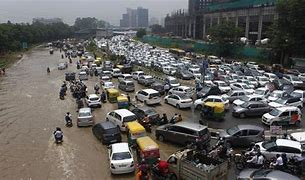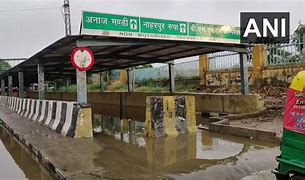
Table of Contents
Drowning in Gurugram: Rs 100 Crore Spent in 3 Years, Yet Flooding Persists
Gurugram, one of India’s rapidly growing urban centers, has been grappling with severe flooding issues despite substantial investments in infrastructure. Over the past three years, approximately Rs 100 crore has been allocated to address the city’s drainage and flood management problems. However, the persistent and recurrent nature of the flooding underscores the challenges and inefficiencies in managing urban water resources and infrastructure.
The Flooding Crisis in Gurugram
Gurugram, located in the National Capital Region (NCR), is known for its booming real estate, burgeoning IT sector, and cosmopolitan lifestyle. However, the city has been facing severe flooding during the monsoon season for years. The heavy rains exacerbate the situation, overwhelming the city’s drainage system, leading to waterlogging on streets, disruption of daily life, and damage to property.
Flooding in Gurugram is attributed to several factors:
- Rapid Urbanization: The city’s rapid growth has led to extensive construction and development, reducing the natural drainage capacity of the land. Paved surfaces and concrete structures prevent rainwater from being absorbed into the ground, increasing runoff and strain on the drainage system.
- Inefficient Drainage Systems: The existing drainage infrastructure is often insufficient to handle the volume of water during heavy rains. Poorly maintained or outdated drainage systems contribute to the problem, leading to frequent waterlogging.
- Waste and Blockages: Accumulation of waste and debris in drainage channels often causes blockages, further impeding the flow of water and exacerbating flooding issues.
The Rs 100 Crore Investment
In response to the recurring flooding issues, the Haryana State Government and Gurugram Municipal Corporation have invested approximately Rs 100 crore over the past three years to improve the city’s drainage and flood management infrastructure. This significant expenditure has been directed towards several key areas:
- Upgrading Drainage Systems: Funds have been allocated to upgrade and expand the existing drainage systems, including the construction of new drains and the enhancement of existing ones to increase their capacity.
- Stormwater Management: Investments have been made in developing stormwater management systems, including rainwater harvesting and retention ponds designed to capture and manage runoff.
- Desilting and Maintenance: Regular desilting of drains and maintenance work has been carried out to ensure that the drainage systems remain functional and free of blockages.
- Infrastructure Projects: Various infrastructure projects aimed at improving road drainage, elevating roads in flood-prone areas, and creating better water discharge mechanisms have been undertaken.
The Persistent Problems
Despite the substantial financial outlay, Gurugram continues to experience significant flooding issues. Several factors contribute to the persistence of these problems:
- Inadequate Implementation: Some of the projects funded by the Rs 100 crore may not have been implemented effectively. Delays in project execution, substandard work, or mismanagement of funds can lead to inadequate infrastructure that fails to address the problem comprehensively.
- Scaling Issues: The investments made may not be sufficient to cope with the scale of the problem. Given the rapid growth of Gurugram, the drainage systems and infrastructure improvements may be outpaced by the increasing urban development and population growth.
- Climate Change: Changing weather patterns and increased frequency of heavy rainfall events due to climate change can exacerbate flooding issues. Even well-designed systems may struggle to handle the intensity of rainfall brought about by climate variability.
- Lack of Integrated Planning: Flood management requires an integrated approach that includes urban planning, land use management, and infrastructure development. A lack of coordination between these elements can result in piecemeal solutions that fail to address the root causes of flooding.
Community Impact and Concerns
The recurring flooding has a significant impact on the residents of Gurugram:
- Daily Disruptions: Flooding disrupts daily life, leading to traffic jams, difficulties in commuting, and loss of productivity. Businesses and services are often affected, causing economic losses.
- Property Damage: Homes, vehicles, and businesses frequently suffer damage from waterlogging, leading to financial strain for affected individuals and businesses.
- Health Risks: Stagnant water can become a breeding ground for diseases, including vector-borne diseases like dengue and malaria. The health risks associated with flooding are a significant concern for residents.
- Public Discontent: The persistence of flooding despite significant investments has led to public frustration. Residents often question the effectiveness of the measures taken and demand better solutions and accountability from authorities.
Government Response and Future Directions
The Gurugram Municipal Corporation and state government are under pressure to address the ongoing flooding issues effectively. Several steps are being considered and implemented:
- Enhanced Monitoring: Improved monitoring and data collection on rainfall, water levels, and drainage system performance can help in better planning and timely interventions during floods.
- Community Engagement: Engaging with the community to raise awareness about flood preparedness and involve residents in reporting and managing local drainage issues can contribute to more effective flood management.
- Innovative Solutions: Exploring innovative solutions, such as green infrastructure, permeable pavements, and improved urban design, can help in managing stormwater more effectively and reducing runoff.
- Integrated Planning: Adopting an integrated approach that combines urban planning, infrastructure development, and environmental management is crucial. Coordination among various agencies and stakeholders is essential for a comprehensive flood management strategy.
- Investment in Long-Term Solutions: Ensuring that investments are directed towards long-term solutions rather than short-term fixes can help in building a more resilient flood management system. This includes considering future growth and climate change impacts in planning and design.
Conclusion
The ongoing flooding crisis in Gurugram, despite an investment of Rs 100 crore over three years, highlights the complexity and challenges of managing urban water resources in a rapidly growing city. The substantial expenditure on drainage and flood management infrastructure underscores the commitment to addressing the issue, but the persistent problems reveal the need for more effective implementation, integrated planning, and innovative solutions.








